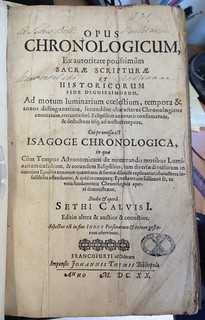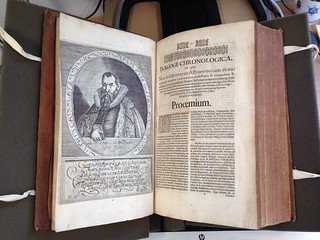My time in Special Collections at the University of St Andrews has been exciting and enriching. I’ve been cataloging 17th century books on history, primarily historical chronologies.
The first book I worked on was the 1620 edition of Opus Chronologicum by Seth Calvisius, printed by Johann Thieme in Frankfurt an der Oder, Germany. Calvisius was a well-rounded man, working as a singer, musician, composer, and astronomer. Johann Thieme was an equally busy person. In addition to his printing and publishing trade, Thieme was also mayor of Frankfurt an der Oder.

Opus Chronologicum, variant B (Special Collections. University Library. University of St Andrews. St Andrews, United Kingdom)
After transcribing the entire title, statement of responsibility, edition statement, and imprint of the book, I looked up the authorized forms of the names of the author and printer in the Library of Congress authorities and VD17 (The Bibliography of Books Printed in the German Speaking Countries from 1601 to 1700). Including as much information from the title page as possible enables a researcher to better find an item and provides a more accurate representation of the item itself.
Additionally, I had to record the pagination and collation statements for the book. This large volume had multiple paginations. After page 178, the numbering sequence restarted, going from 1-900. Thirty pages of an unnumbered index followed. The majority of the signatures had six leaves, with the last two containing only four. With pagination and collation statements, one can not only identify this edition from later editions, but also this specific copy from ones at other institutions.

Opus Chronologicum, variant A with engraved portrait. (Special Collections. University Library. University of St Andrews. St Andrews, United Kingdom)
After I finished the record for this book, I was surprised to find the next book in the queue was the same, albeit a different variant. This second copy contained an engraved portrait in the preliminary pages, while the first copy did not. I added more copy-specific notes, including provenance and binding information, and moved onto the next book. I was even more surprised to find that the third book was also the same, this one lacking the engraved portrait like the first copy.
Even though all three books were the same edition, there were differences in the bindings, the history of ownership, and even the way page numbers were inked. Recording copy-specific information like this can help researchers trace the history of publishing, printing, reading, and even libraries. At a university as old as St Andrews, many of the books from the 16th and 17th centuries were purchased around the time they were actually created, unlike newer institutions that purchase or receive books that have been collected over the years.
